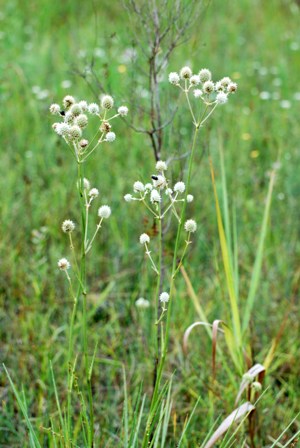Rattlesnake Master
Eryngium yuccifolium
Rattlesnake Master is also called Button Snakeroot and Button Rattlesnakemaster. The linear leaves are up to two feet tall with soft spines along the edge resembling a small yucca plant. The flower heads may reach up to four feet tall.
Half inch round globes of tiny white flowers bloom in mid summer and attract a variety of pollinators including wasps, bees, beetles, pollinating flies and butterflies.
The small nutlets that mature in fall are eaten by a seed eating moth’s larva. I have never seen, nor found information that birds eat the seeds.
This is a plant of our wet pineland prairies and needs moist sandy soil with low amounts of organic matter and nearly full sun to survive.
Although it is related to fennel and parsley, it is not a larval host for the Eastern Swallowtail Butterfly. The pollinators it attracts and the interesting foliage and white flowers are what make this a great addition to a pollinator garden.
Our Florida form has thinner, more spiny leaves than the western form. Pictures in catalogs and some of the links below show the western form.
Although this plant grows in moist to wet sandy soil, it will do fine in a normal moist garden with moderate levels of organic matter.
Rattlesnake Master goes well with Tickseed Coreopsis, Pineland Dropseed, Splitbeard Broomsedge, Lopsided Indiangrass, Spiderworts, Florida Lily, Swamp, Marsh, Hottentot and Virginia Chain Fern. Try Sunshine Mimosa, Fogfruit, Water Hyssop (if always wet) as low, non competing ground covers. And in fertile soil, Prairie Iris, Yellow Canna and American Crinum Lily.
